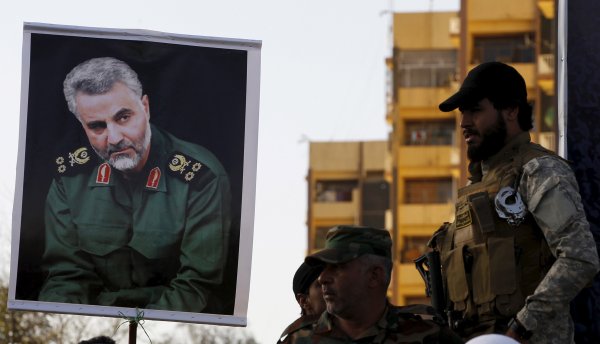The US killing of Iranian general Qasem Soleimani was meant to cripple Tehran's clout in the Middle East, but analysts see the allies of the Islamic Republic closing rank instead.
As the head of the Iranian Revolutionary Guards' Quds Force, Soleimani oversaw Tehran's interventions in regional power struggles from Lebanon and Iraq to Syria and Yemen.
Washington had hoped his killing in a Baghdad drone strike Friday would deal a blow to Iran and its network of proxies -- but the plan appears to have backfired by uniting pro-Iran factions under an "axis of resistance".
"The strike unified the resistance forces and made combatting the United States a priority," said Qassem Qassir, a Lebanese expert in Islamic movements.
"The assassination was a strategic mistake, and the response will be across the region -- not just limited to Iraq," said Qassir. Indeed, pro-Iran factions in Iraq have seized on the strike to secure a political and popular revival.
Kataeb Hezbollah, a vehemently anti-American armed faction in Iraq, said the strike was "the beginning of the end of the US presence in the region".
Iraqi populist cleric Moqtada Sadr swiftly reactivated his Mahdi Army, the notorious militia that fought US troops after the American-led invasion of 2003. "Th e Iraqi factions of the resistance must hold an immediate meeting to form the International Resistance Regiments," he tweeted, telling his fighters to "be ready".
'Turn the skies to hell'
Qais al-Khazali, a paramilitary leader and bitter rival of Sadr's, echoed his calls for fighting units to mobilise following the strike on Soleimani.
Khazali also threatened US troops who have been stationed across Iraq since 2014 as part of the global coalition battling the Islamic State group.
On Sunday, Iraq's parliament voted in favour of ousting US troops although the decision rests with the government.
"If you don't leave, or if you procrastinate in leaving, you will find a strong Iraqi response that will shake the ground beneath your feat and turn the skies above you into hell," Khazali warned. Even Grand Ayatollah Ali Sistani, Iraq's highest Shiite authority, broke with standard protocol to mourn Soleimani.
In a first, Sistani sent a letter to Iran's Supreme Leader Ali Khamenei to offer his condolences. Further afield in Lebanon, Iran-backed Hezbollah said the strike represented a threat to "all the movements, leaders and countries of the axis of resistance".
The killing of "Qasem Soleimani is not an Iranian issue. It concerns the axis of resistance -- it concerns the Muslim world," said the movement's influential head Hassan Nasrallah.
Iran-backed Houthi rebels in Yemen, meanwhile, called for "direct and swift reprisals" to the strike. Palestinian movement Hamas slammed it as an "American rampage," and its head Ismail Haniya travelled to Tehran for Soleimani's funeral.
And the leftist Popular Front for the Liberation of Palestine also urged "a coordinated, comprehensive and continuous response from resistance forces".
'Closing of rank'
"There could be a closing of rank and a reinforcement of the confessionalism," said Karim Bitar of the Paris-based Institute for International and Strategic Affairs.
He said Iran's allies in the region would set economic or political goals aside to prioritise the "emergency security situation" triggered by Soleimani's death. "Soon enough, this decision by (US President) Donald Trump will be seen as counter-productive," Bitar predicted.
Trump has threatened Iran with "major retaliation" if it responds to the strike, openly warning in a tweet on Sunday that US action may even be "disproportionate".
He had already threatened to bomb 52 unspecified targets in Iran if Tehran attacks US interests in the region.
"Tehran has the sword of Damocles hanging over its head," Bitar told AFP.
"But the threat of foreign intervention will reunite Iranians of all social classes, both opponents and supporters of the regime," he said.
Indeed, unprecedented crowds have turned out in Iran to mourn Soleimani and the four other Revolutionary Guards killed in the US strike. Ultimately, the assassination could end up bolstering the Iranian government, which will benefit from a phenomenon of "rallying around the flag," Bitar said.
Read more: https://www.al-monitor.com/pulse/afp/2020/01/iraq-iran-us-unrest-shiite.html#ixzz6AGi9VfVE
Escalating costs at the Seaspan Shipyard in Vancouver in 2019 depleted the multi-million dollar contingency fund set aside as part of the budget to build three offshore fisheries science vessels under Canada's National Shipbuilding Strategy.
The Canadian Coast Guard Ship John Franklin and CCGS Capt. Jacques Cartier were delivered in 2019, and a third ship is expected this year.
The 63-metre vessels are the first large civilian ships produced under the federal shipbuilding program. They will be used to monitor fish stocks and ecosystems.
The $687-million budget included an escalation contingency fund. The amount was not disclosed.
The full amount was redacted in a federal document authorizing the final dip into the fund. It was released to CBC News under access to information legislation.
Millions already spent by last May
According to a memorandum prepared for Jonathan Wilkinson, the former minister of fisheries and oceans, the project had already used $19 million in contingency funds by May 2019.
But more was needed, the memo said, to cover "escalating project costs such as labour rates and owner's changes, as well as other unexpected increases to project costs including transition into service costs."
"Access to the remainder of the contingency funding [redacted] is now required," the two-page memo said.

A decision was needed by July 5, 2019, the note said, "in order to adjust the Shipbuilding Contract with Vancouver Shipyards in a timely fashion and further advance the project in a seamless manner."
Wilkinson signed off on the request.
A small percentage of overall budget
The Department of Fisheries and Oceans would not disclose the amount, but said Wilkinson was not asked to approve new funding.
"The overall contingency fund is a small percentage of the overall budget of $687 million, and is a pre-planned funding amount to cover potential increases to labour rates at the shipyard, economic price and foreign exchange adjustments, and any necessary changes to operational requirements that surface over the 5-year project implementation phase," DFO spokesperson Benoit Mayrand said in a statement to CBC News.
"The total value of available contingency funding cannot be released, as its use will be subject to negotiations with the shipyard," he said.
In an emailed statement, Seaspan spokesperson Amy MacLeod said "requests for contingency funding is a normal, ongoing part of the contracting process on large projects such as the [National Shipbuilding Strategy]."
What we know about the funding deal
When the agreement in principle with Seaspan was announced in 2015, the total project budget was set at $687 million.
Federal officials said at the time the total included $59 million for project management, work up to that date and contingencies, $51 million for engineering costs, and the remainder for construction, contingencies, insurance, warranty, spares and training material.
Seaspan committed to deliver three offshore fisheries science vessels at a total ceiling price of $514 million.
The ceiling included fees and an allowance for contingencies "that may or may not be required to address the risks associated with building a new class of ships in what is essentially a brand new shipyard."













